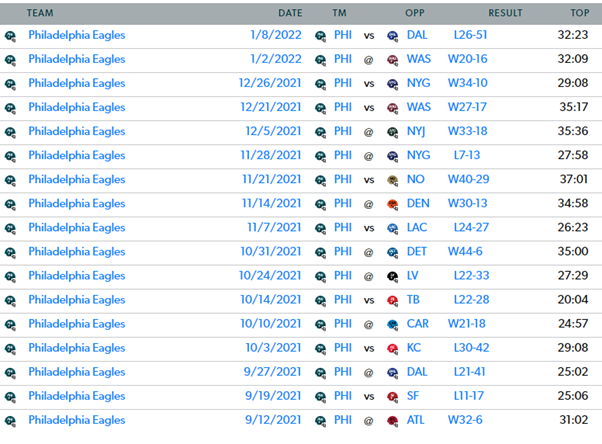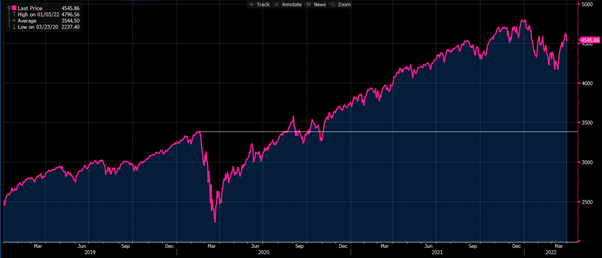As an NFL enthusiast and Philadelphia Eagles fan, I’m well aware of the concept of “Time in Possession”, which is a statistic measuring the percentage of a game that a team’s offence has the ball.
Time in possession isn’t necessarily something that leads to wins, as a team can have little to no possession and still score more points than their opposition, but it does indicate that a team is likely to have a greater chance to score, because they can dictate the pace of the game and the way that it’s played.
For example, looking at the past twenty games the Eagles played in, there’s a noticeable correlation between TOP/TIP and whether they won or lost.
The higher the TOP/TIP, the more possession, and higher likelihood they won.
Table 1: Philadelphia Eagles Win/Loss Vs Time in Possession

Source: Statmuse.com
This metric isn’t just an NFL stat either, my beloved Arsenal (soccer) used to be known for it, as a reason for their dominance in the 2003/04 season, winning the Premier League by an 11-point margin and giving the other teams less chance to score.
Time in possession isn’t just a good metric for sports either, it works for financial markets.
See, in financial markets we tend to focus on changes in price levels, not about the time in which these things occur.
As educated investors, we need to think about both, as time influences psychology just as much as price does.
For example, in March 2020, US stocks dropped 35%, one of the largest bear markets in equity market history from a price change perspective, but they were back in the green within only a few months.
Peak-to-peak, 20/Feb until 10/August.
Chart 1: S&P 500 Price Chart, 2019 until present

Source: Bloomberg, as at 5/April/2022
If you were thinking about time in possession, the bear market was the dominant regime for only five months and didn’t have a prolonged effect on investor psychology.
Compare this to the Great Depression – the name alone tells you what the impact was – where markets stayed down from 1929 to 1946.
The Great Depression, in contrast to the 2020 Pandemic Recession, had a profound and lingering effect on global investor psychology, and is largely attributed as the reason for the next 20+ years of investors keeping a large portion of their portfolios in cash and government bonds rather than venturing out along the risk/return curve.
Each Recession is Different
Recessions are defined as two consecutive negative quarters of real GDP growth (or more), whilst “bear” financial markets are a -20% price drop peak-trough for financial assets.
Bear markets can often outlast the recession in time, with equity markets trading at below-recession levels for years.
In 2020’s case, US equities rebounded quicker than the recession, where equities regained losses quicker than economic growth recovery.
In the GFC’s case, US stocks were in bear market territory for 21 months in the GFC, moving positive again in March 2009.
During the Dot-com Bubble, 14 years from peak to peak for the Nasdaq.
Chart 2: NASDAQ Composite Price Chart, 1999 to 2017

Source: Bloomberg
In studying these recessions, associated bear markets and recoveries, is that qualitatively, time in possession – as in, the longer the bar market – the more profound change in investor behaviour.
For the Dot-com bubble, broad tech exposure was not a mainstream concept for years and years, not until the likes of Amazon, Facebook, Google really started to take off.
Learning from the Pandemic Bear Market
With the above as context, when we look at current retail investor exuberance and the wide-spread belief in the “Fed put” option buoying markets, where prime broker data has shown the recent rally in developed market equities is due to retail buying, it is clear that there is a lack of psychological effect from an extended bear market associated with the pandemic. While hard to prove, if global central banks hadn’t been as stimulatory in response to the pandemic, and markets had taken longer to correct, then likely we wouldn’t have the same level of FOMO (fear of missing out) in equity markets.
This has some interesting throughput into future investor decisions.
Investors have been resolved that central banks are indeed buyers of last resort, and are increasingly broadening their policy toolkit, and in some cases, buying corporate bonds and even equity ETFs to stabilise capital markets.
If we take this one step further, then likely if you aren’t positioned for a correction, investors will perceive it to be a good idea not to sell and just ride things out, as in the past ~15 years of investing, they simply needed to hold for 6-18 months and they broke even.
Ergo, this FOMO paradigm rewards a lack of risk-management, where those that invest with discipline – with regularly updated entry and exit prices – underperform because they don’t simply Hold on for Dear Life (HODL), a term associated with cryptocurrency investment.
Closing Remarks
When you’re aware of time in possession, you’ll start to see it everywhere.
You’ll see it in government bond markets where yields have conformed to a 40-year downtrend, and now that they’re back up ~100-150bp people are already buying the dip, because the bull-market has had an extended time in possession, and the bear market has only been around for 6 months so far.
Likewise the buy-the-dip mentality in equities over the same period, or likely the same behaviour we’ll see in domestic residential property, as the RBA raises rates but Australian investors will happily buy the dip because Australian property only goes up in value, right?
[To be clear, it doesn’t]
Time in possession matters, and if we’re entering a new regime in the 2020s that differs from the disinflationary, central bank has got your back 2010s, then it’ll take quite a while for a lot of investors to realise the change in paradigm.
The views expressed in this article are the views of the stated author as at the date published and are subject to change based on markets and other conditions. Past performance is not a reliable indicator of future performance. Mason Stevens is only providing general advice in providing this information. You should consider this information, along with all your other investments and strategies when assessing the appropriateness of the information to your individual circumstances. Mason Stevens and its associates and their respective directors and other staff each declare that they may hold interests in securities and/or earn fees or other benefits from transactions arising as a result of information contained in this article.



